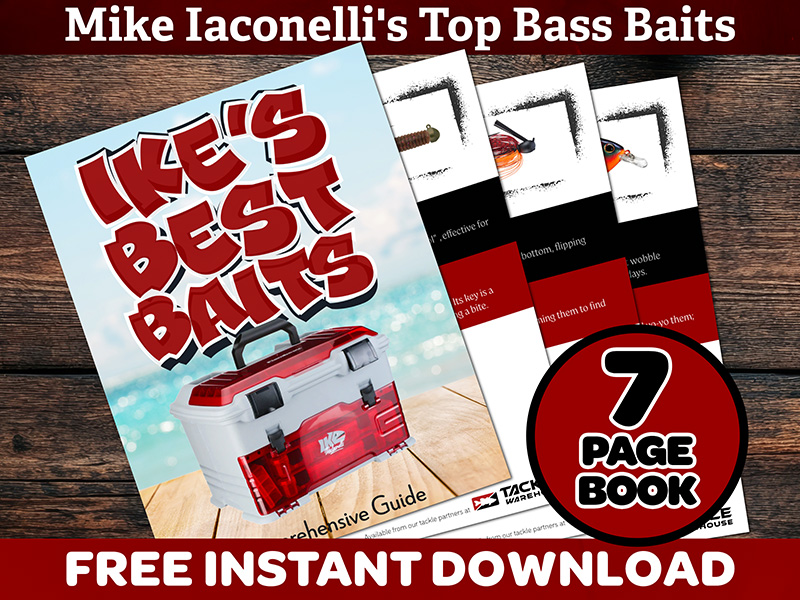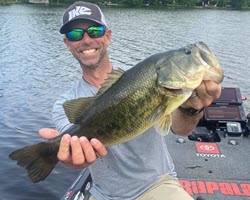
All over the country, July means HOT weather. The water is hotter, the air is hotter, and the days are longer. That tends to push the bass deeper, where the oxygen content is higher, the water is cooler, and their prey is located. Of course, deep is a relative term. In some California reservoirs it might mean 100 feet, while in Florida it could mean 8 or 10 feet, but this is the time to focus much of your effort there.
With that in mind, I’m going to give you information about four of my favorite July baits, two for up north and two for down south, using a line roughly at Virginia as the dividing point.
My number one choice for just about anywhere, but especially up north, is a dropshot. It works well shallow, but it’s exceptional out deeper. Whether you’re fishing in 8 feet of water or 50, it gets down to the bottom and stays there. More importantly, it does a great job of mimicking all kinds of natural forage. With the weight on the bottom and the bait hovering horizontally above it, it’s super-realistic, whether the bass are feeding on shad or bluegill or gobies or anything else.

Increasingly my favorite soft plastic choice for this technique is the Berkley Maxscent Flat Worm. It comes in two sizes and I tend to use the larger 4.25” model more than the smaller one, especially around largemouths and spots. It’s a little bit bigger and tends to produce better quality fish.
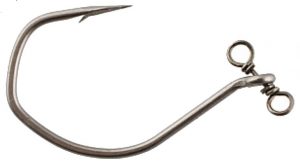
My rule of thumb when it comes to hooks is that any time I can get away with an exposed hook I like to use one. So when I’m around sparse cover I nose hook the Flat Worm with a VMC dropshot style hook. Just stick it in about an eighth of an inch and run it back out, with the flat side of the worm facing down.
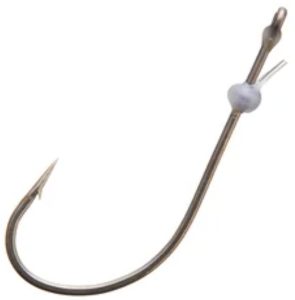
This technique is just as effective around cover like milfoil and cabbage and hydrilla, but you’ll have to bury the point of the hook. In that case, I use a VMC finesse Neko style hook. It’s the same one that I use with a wacky rig, except it has a little keeper barb to keep the worm in place. I like a 1/0 or 2/0 with that 4.25” worm.
When it comes to leader length, my general rule is that the cleaner the water, the longer you go, and the dirtier the water the shorter you go. That could mean 14-18” in clear water, and as short as 6-8” in dirtier water.

My second northern lure choice for July is something you might have heard people talking about, but it’s still kind of a sleeper. It’s the Ned Rig – just a blunt, stubby, no action worm on a mushroom style jig head. There are lots of different heads out there. Just make sure that you pick one with a 90-degree line tie. It helps the bait stay horizontal and spiral a little on the fall. I keep it pretty light, usually from 1/16-ounce to 1/4-ounce at the max. You can use any stubby, straight tail worm. In fact, I often just cut a 5” Berkley General in half.
The Ned Rig is so easy to fish. In fact, many people mess it up by overworking it. Just let it fall on a semi-slack line. While it falls, if that line jumps or you see a tick, set the hook. About 20 or 25 percent of your bites will come on the fall. That means that the majority will occur when it’s just sitting there, acting non-threatening. You make that happen by letting it hit the bottom and then making a slow drag. I call it “counting pebbles.” The minute it hits something substantial I stop and let it do nothing. If I don’t get a bite there, I resume the drag.

Now let’s move to southern fisheries, particularly the big river-run reservoirs, and my third choice: The swimbait. This is swimbait season! In particular, I mean a jig head style swimbait with a boot tail, like a Berkley Hollow Belly or Power Swimmer. I pair it up with a VMC Hybrid head which has a screw lock, so you won’t have to spend a lot of time adjusting your lure.

Some of the key zones for the swimbait are between 14- and 18-feet, but you can go much deeper. It drops in a hurry and stays in the strike zone. Once it’s there, the bait does a lot by itself. As you reel it, it has kind of a dual action, a combination of a body roll and tail wag that makes it irresistible. It looks like a big easy meal, something like a gizzard shad, a shiner or a blueback herring.
Last but not least, I want to highlight a lure that’s at its absolute best this time of year. It’s one that has produced a lot of my biggest bass, and while it gets lots of play in the south, it’s also a sleeper up north: The flutter spoon.
The flutter spoon does a great job of imitating dying forage, baitfish that are on their last legs. I like the Molix Lover spoon, usually a ¾-ounce in 0 to 20 feet of water, and the giant 1-ounce model any deeper than that. Most of these flutter spoons get their action from the cupped metal, including the Molix, but it has two features that differentiate it. The first is a built-in stinger hook that stays tight to the body with a little magnet. A lot of bass will head butt or flash at the spoon, and this extra hook grabs those short strikers. The second difference is less obvious but equally important: it’s the two fluted back corners of the spoon. Most of these spoons are just good on the fall, but the Lover also excels when you’re reeling it. Fish it around main lake points and ledges and humps and you’ll be surprised at how many big bass you catch.
This is another lure that you let fall on a semi-slack line. If it’s on total slack, you’ll lose control, and if it’s on a tight line it’ll pendulum back. Let it go down and if you see your line jump, turn or stop, set the hook! When it hits the bottom, you want to lift it and let it fall as many times as possible in the strike zone. Just rip your rod up from 3 o’clock to 12 and then let it fall. Every fourth rip I use two pumps to change the movement. Keep your color choices simple: chrome or silver on bright days, and painted models (such as white) in cloudy or low light conditions.
In July the weather is hot, but there’s no reason that the fishing can’t be hot, too. In fact, if you put these lures on the deck of your boat, you might enjoy some of your best trips of the year.
_______________________________________________
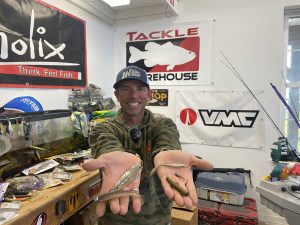
___________________________________________________
Like Ike on Facebook, and follow him on Instagram and TikTok for fishing and fun content.
Subscribe to Mike’s YouTube channel, to ensure you see every adventure video. (Download the YouTube app on your phone and the videos will come to you automatically.)
Return to Mike Iaconelli’s website


















